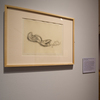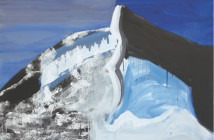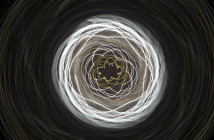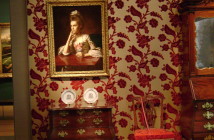| The Art of Mastering Life by Brian Francois |
| Observing to Make Sense by Kerry Rubenstein |
| A Joyous Bundle of Summations by Daniel Horowitz |
| Art Does Not Reproduce the Visible by Libby Leyden-Sussler |
In lieu of a traditional review, for January we bring you a matrix of reviews written by four students from Milda Richardson's class at Northeastern University. A review is a complicated beast. No one answer can incorporate everything about a show, and no reviewer should ever be considered the only authority on a subject. We hope that you find this group of responses interesting both for their content and in their comparisons.
University art galleries and museums offer opportunities for exhibitions that do not fit into the traditional formalist critical standards. These smaller institutions often engage in exhibitions that are too specialized or too experimental to find a home in larger museums that function largely as public institutions. Because their shows are not always in the mainstream, they draw a select audience with defined interests. The artworks are often second or third tier value in the marketplace, but they provide a deep and detailed account of cultural history. In the main, college exhibitions are teaching instruments for hands-on use by students and the scholarly community. In many cases they are collection-based, convention challenging exhibitions, rather than powerhouse displays of masterworks. These in-house exhibitions diversify the classroom experience and help prepare students to grapple with the challenges of new technology. Such exhibits enrich the academic ambiance while evoking an organic and intimate mood. Because of limited resources, many shows are no frills with few money-making products. But this does not diminish the fact that many of these university-sponsored shows demonstrate lively personality. It is typical for the collegiate museums to avoid didacticism and offer art as conversation, rather than statement. If it weren’t for academic museums, these kinds of shows would not happen.
A particularly successful example of art as a conversation was the exhibition entitled "Paul Klee. Philosophical Vision: From Nature to Art" at the McMullen Museum at Boston College, Sept. 1 — Dec. 98, 2012. Witness to the success are some enthusiastic comments produced by several Northeastern University students from the Department of Art + Design who were enrolled in my Modern Art 1900-1945 course. The assignment to review the Klee show was the capstone to preparatory study of topics such as the relationship between Stravinsky’s Petrushka ballet, 1910-11, and Suprematist painting or Symbolist poetry and paintings by Lithuanian artist and composer M.K. Ciurlionis. The study of the history of the Bauhaus became the foundation for an in-depth look at Klee, one of prominent teachers at the Bauhaus. The intellectual adventure that resulted produced a group of essays which are marked by emotions expressing surprise, curiosity and intense impressions.
Elissa Abrahams’ observation provided a concise summary of similar thoughts by most of the other students regarding the overall organization of the exhibit. "The viewer is taken on a journey that begins with the genesis or creation and comes full-circle. It seems that the curators wanted to ease the viewers into the philosophical thoughts of Klee with each successive theme providing another layer of substance, at each point adding on new ideas and perspectives. The organization of the eight themes, each of which was placed in color-coordinated areas of the gallery spaces, helped convey Klee’s vision, with nature as the point of departure. It is clear that Klee acknowledged nature as one of the sources of his creativity."
Rebecca Smith focused on the viewer physically moving through the gallery spaces. She noted how, when descending the stairs, the three large black and white portraits of Klee are contrasted against the lavender wall, thus creating a powerful effect.
The students were sophisticated enough to recognize multiple relationships between contiguous works. Ailyn Pestana, for example, pointed out the placement of Klee’s "Concert on the Branch" and "The Twittering Machine, Klee’s famous critique of technology. In both works, the birds sing, but do not fly. Sarah Alkuhaimi zeroed in on the theme of the occult. "An example is Klee’s musical ghost, a minimalist representation of a man, appearing under a line, as if sprouting from some musical notes and instrumental forms. The image is inverted, thus creating a creepy, spooky feeling."
In the section titled "The Failure of Politics," Emilia Emerson described the pencil drawing Violence, 1933. "The drawing depicts several figures in poses of suffering as consequences of war. The figures are more gestural and implied, made up entirely of violent scribbles revealing no discernible features. With the introductory wall text in mind, I concluded that this gestural style of the drawing was meant to convey primal emotions of chaos, pain, and terror. This drawing clearly shows Klee’s contempt for gratuitous innocent suffering."
Three layers of supporting texts unspooled Klee’s complex thoughts and made them more accessible. Using the extensive wall texts, Ashlie Meyer came to the conclusion that "Complex issues such as criticism of modern technological innovation, the idea of art as the depiction of nature’s latent truths, and the precarious position of man in modern society are all tackled in the exhibition. The explanations of the themes made it easy for the viewer to relate to the works. At the same time, each work feels like a private entry into Klee’s philosophical development, allowing viewers to generate their own understanding of the works’ meaning."
There was universal appreciation for the inclusion of Klee’s own writings to help viewers understand Klee’s creative thought process. Laura Tobon understood the importance of a third voice, namely the film, which she said, "makes the exhibition much stronger since the audience is able to hear the opinions of others, not exclusively the curators’ choice of words."
Elissa Abrahams was insightful when she stated that, "What makes Klee’s thoughts contemporary is the fact that they were not based in traditional religion, but rather, Klee was more interested in the world of the spirit realizing that as humans we have a dual nature, seen and unseen."
For most students what was fundamentally important was coming to understand art history as a process of cross-fertilization of movements and individual creativity and how movements were created not only by artists but by philosophers and musicians alike. Kim Winter, who had visited the Zentrum Paul Klee in Switzerland, wrote, "I think that significant environmental issues can be taken away from this exhibition due to Klee’s focus on the beauty of nature and animal life."
All effective teachers use cultural resources to enhance the curriculum. Education should be built on rich examples of human achievement, such as we saw in the Paul Klee exhibit at McMullen Museum. I was struck by the fact that this particular show cultivated a certain mental agility on the part of students to understand their own creative process. We are deeply indebted to the editors of Big, Red & Shiny for the opportunity to share our experience with the community.




